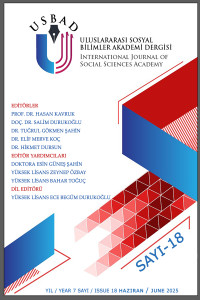Abstract
Filistinliler, modern dünyada milliyetçi veya dinsel ayrımcılığa maruz kalmış, en kotu kaderleri yaşayan uluslardan biridir. Yaşanan felaketlerin temel nedeni, çarpıcı bir noktayı ortaya çıkarır; benzer ayrımcılığa ve mağduriyetlere maruz kalan millet olarak İsrailliler, mevcut çatışmanın nedeni ve faili olarak karsımıza çıkar. İsrailliler, Filistinlilere yönelik nispeten olumlu muameleyi veya ortak kültürel veya tarihi geçmişlerini dikkate almaksızın, maruz kaldıkları zulümlerin çok daha fazlasını Filistinlilere karşı uygulamıştır. Sandy Tolan'ın Limon Ağacı (2006), İsrail ve Filistin çatışmasını, onların günlük yaşamlarını ve her iki ulusun acılarını, deneyimlerini ve umutlarını yansıtıyor. Hem Avrupa'daki Yahudilerin hem de Filistin'deki Arapların yaşadığı çatışmaların yansımaları ustalıkla işlenmektedir. İkili karşıtlıklar ve Oryantalizm’in ötekilik kavramı vurgulanmıştır. Bu çalışmada, Avrupa ve Filistin'in çok kültürlü yapısı, toplumsal oluşum süreçleri, kasıtlı ayrımcılık ve önyargıların çerçevelenmesi, insan hakları ihlalleri kurgusal olmayan anlatı ışığında ortaya çıkarılıp örneklendirilmektedir. Bu çalışma, Yahudilerin önceden nasıl mağdur edildiğini, sonra bu durumdan nasıl yararlandıklarını ve zalim rollerini nasıl yerine getirdiklerini açığa çıkarır.
Keywords
References
- Babalola, C. A. (1986). A Reconsideration of Achebe's No Longer at Ease. Phylon (1960-), 47(2), 139-147.
- Bhabha, H. K. (1996). Culture’s in Between, in Hall Stuart and Gay, Paul. (eds) Questions of Culture Identity (pp. 53-60). London: SAGE.
- Boylu, Y. (2019). Victims of nationalism: A comparative study of the Lemon Tree and Sevdalinka, (Master Thesis). Bingol University.
- Cleary, J. N. (2002). Literature, partition and the nation-state: culture and conflict in Ireland, Israel and Palestine (Vol. 10). Cambridge University Press.
- David, L. (2017). Holocaust and genocide memorialisation policies in the Western Balkans and Israel/Palestine. Peacebuilding, 5(1), 51–66.
- Fanon, F. (2008). Black Skin, White Masks, New York: Grove Press.
- Herman, J. L. (1997). Trauma and Recovery: The Aftermath of Violence-From Domestic Abuse to Political Power. New York: Basic Books.
- Koffman, D. (1996). Five. Israel and the War in Bosnia. In T. Cushman & S. Mestrovic (Ed.), This Time We Knew: Western Responses to Genocide in Bosnia (pp. 90- 127). New York, USA: New York University Press.
- Lindfors, B. (1997). Conversation with Chinua Achebe, United States: University Press of Mississippi.
- Long, J. C. (2008). Rooting diaspora, reviving nation: Zionist landscapes of Palestine– Israel. Transactions of the Institute of British Geographers, 34(1), 61-77.
- Mason, V. (2007). Children of the "Idea of Palestine": Negotiating Identity, Belonging and Home in the Palestinian Diaspora. Journal of Intercultural Studies, 28(3), 271-285.
- Said, W. E. (2003). Orientalism, London: Penguin.
- Sharif, R. (1983). Non-Jewish Zionism. London: Zed Press.
- Tolan, S. (2006). The Lemon Tree, London: Black Swan.
- Tyson, L. (2006). Critical Theory Today. Newyork: Routledge.
Abstract
The Palestinians are one of the nations experiencing the most aggrieved fates with regard to national or religious discrimination in contemporary world. The main reason of the miseries reveals the stunning point as the Israelis, the nation exposed to similar discrimination and hurt, is the cause and the committer of the current conflict. The Israelis have overdone the atrocities they have faced regardless of the relatively welcoming treatment of Palestinians or their common cultural or historical backgrounds. The Lemon Tree (2006), by Sandy Tolan, mirrors the Israeli and Palestinian conflict, their daily lives, and both of the nation’s sufferings, experiences and hopes. The reflections of the conflicts experienced by both the Jews in Europe and the Arabs in Palestine are skillfully portrayed. The binary oppositions and Orientalism’s concept of otherness are underscored. In this study, the multicultural structure of Europe and Palestine, the processes of social formations along with framing deliberate discrimination and prejudice, human rights abuse are revealed and exemplified in the light of the non-fiction narrative. The study displays how the Jews were victimized beforehand, how they make use of this case, and how they carry out their role as victor.
References
- Babalola, C. A. (1986). A Reconsideration of Achebe's No Longer at Ease. Phylon (1960-), 47(2), 139-147.
- Bhabha, H. K. (1996). Culture’s in Between, in Hall Stuart and Gay, Paul. (eds) Questions of Culture Identity (pp. 53-60). London: SAGE.
- Boylu, Y. (2019). Victims of nationalism: A comparative study of the Lemon Tree and Sevdalinka, (Master Thesis). Bingol University.
- Cleary, J. N. (2002). Literature, partition and the nation-state: culture and conflict in Ireland, Israel and Palestine (Vol. 10). Cambridge University Press.
- David, L. (2017). Holocaust and genocide memorialisation policies in the Western Balkans and Israel/Palestine. Peacebuilding, 5(1), 51–66.
- Fanon, F. (2008). Black Skin, White Masks, New York: Grove Press.
- Herman, J. L. (1997). Trauma and Recovery: The Aftermath of Violence-From Domestic Abuse to Political Power. New York: Basic Books.
- Koffman, D. (1996). Five. Israel and the War in Bosnia. In T. Cushman & S. Mestrovic (Ed.), This Time We Knew: Western Responses to Genocide in Bosnia (pp. 90- 127). New York, USA: New York University Press.
- Lindfors, B. (1997). Conversation with Chinua Achebe, United States: University Press of Mississippi.
- Long, J. C. (2008). Rooting diaspora, reviving nation: Zionist landscapes of Palestine– Israel. Transactions of the Institute of British Geographers, 34(1), 61-77.
- Mason, V. (2007). Children of the "Idea of Palestine": Negotiating Identity, Belonging and Home in the Palestinian Diaspora. Journal of Intercultural Studies, 28(3), 271-285.
- Said, W. E. (2003). Orientalism, London: Penguin.
- Sharif, R. (1983). Non-Jewish Zionism. London: Zed Press.
- Tolan, S. (2006). The Lemon Tree, London: Black Swan.
- Tyson, L. (2006). Critical Theory Today. Newyork: Routledge.
Details
| Primary Language | English |
|---|---|
| Subjects | British and Irish Language, Literature and Culture |
| Journal Section | Research Articles |
| Authors | |
| Early Pub Date | June 23, 2025 |
| Publication Date | June 24, 2025 |
| Submission Date | November 11, 2024 |
| Acceptance Date | April 12, 2025 |
| Published in Issue | Year 2025 Issue: 18 |


